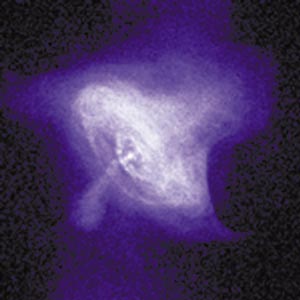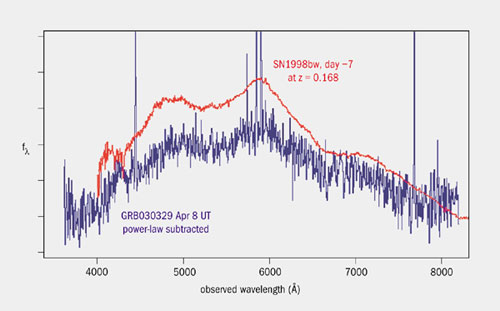On 8 April, astronomers using the 6.5 m Multiple Mirror and Magellan telescopes discovered supernova SN2003dh, at the location of the gamma-ray burst GRB030329 (P Garnavich et al. 2003). The GRB had been spotted 10 days earlier by NASA’s High-Energy Transient Explorer satellite, on 29 March – the estimated time at which the supernova exploded. The association between these two phenomena may now have brought to a close the quest for what it is that generates gamma-ray bursts.

Gamma-ray bursts (GRBs) are flashes of gamma rays that reach us about once a day from deep space. They were serendipitously discovered in 1967 by US military satellites that were intended to monitor nuclear tests occurring above ground, in violation of the nuclear-test-ban treaty. For decades the origin of the GRBs was a complete mystery.
The first indication that GRBs are of cosmological origin was obtained in 1991 by NASA’s Compton Gamma Ray Observatory, which determined that their sources are isotropically distributed in the sky. It was also found that there are two GRB populations: “long-duration” GRBs lasting for more than 2 seconds, and “short” ones lasting less than this. The cosmological origin of GRBs, if the emission is isotropic, implied such a fast and huge energy release that it was even speculated that GRB explosions may involve new physics.
The cosmological origin of long-duration GRBs was first confirmed on 28 February 1997. The BeppoSAX satellite provided the approximate sky position of the long GRB970228 and discovered that it was followed by an “afterglow” – a continuous emission of radiation at longer wavelengths that lasted for a much longer time. This and following observations of the afterglow of long GRBs allowed their precise localization. They occur in distant galaxies in star-formation regions, which hints at their association with the explosive death of massive stars.
On 28 April 1998, ESO’s New Technology Telescope discovered the supernova SN1998bw close to the spiral arm of the nearby galaxy ESO 184-G82. The supernova was within the error box of GRB980425, spotted 2.4 days earlier with the wide-field camera of BeppoSAX. The temporal and directional coincidence of the two objects suggested that they may be physically associated. The distance to SN1998bw is a mere 39 megaparsecs (redshift z = 0.0085), a trifle compared with the gigaparsec distances to other GRBs located at much larger redshifts. Yet the gamma-ray flux from GRB980425 was comparable to that of others and not orders of magnitude larger, as would be expected from a spherical emission from the nearby location of SN1998bw. This led the GRB community to conclude that either GRB980425 and SN1998bw were not physically associated, or if they were, the pair belonged to a rare class of GRBs produced by a new type of gigantic “hypernova”.

The measured spectra of the recent supernova, SN2003dh, looks amazingly similar to that of SN1998bw, as the figure shows. This may be a problem for the generally accepted “fireball” model of GRBs, in which the emission is spherical or due to a “firecone” directed towards the observer, but GRB980425 (coincident with SN1998bw) is a “one of its kind”, extremely underluminous exception, while GRB030329 (coincident with SN2003dh) is a very bright conventional GRB at a relatively small but nonetheless “cosmological” redshift, z = 0.1685. So why should their associated supernovae look so similar?
A group from the Technion Institute in Israel and CERN has long advocated a “cannonball” model of GRBs, totally different from the accepted fireball models. In this model the long-duration GRBs and their afterglows are the radiation from relativistic “cannonballs” emitted by supernovae as their cores collapse. The cannonballs are similar to the ejecta of quasars and microquasars; their observed properties also depend on the angle between the observer and the cannonballs’ velocity vector. Hence, GRB980425 was not exceptional, it was simply viewed at an uncommonly large angle. More distant GRBs can only be seen if their cannonballs point towards the observer better, for the same reason that an accelerator-made beam of neutrinos is most intense close to its source and to its axis.
The advocates of the cannonball model have sufficient confidence in their understanding of GRBs to have correctly predicted, on three prior occasions, when the declining GRB afterglows become dim enough for the associated supernovae – whose light curves first rise with time and then fall again – to be observable. In the case of GRB030329, the team posted a paper on 6 April in the Web “Archives” (S Dado et al. 2003), correctly predicting that “10 days after burst, the AG of GRB030329 should begin to reveal the light curve, spectrum and polarization of an underlying supernova, akin to SN1998bw.”
Whether this model will survive tests of the rest of its very specific predictions remains to be seen. But the discovery of SN2003dh may dispel the doubts that long-duration GRBs are produced by highly collimated radiation from core-collapse supernovae. If so, GRBs are not the long advocated “biggest explosions after the big-bang”, but simply supernovae “playing high-energy accelerator physics”, that is, spending a modest fraction of their energy budget in the acceleration of matter to relativistic speeds. Precisely how they do it, particle physicists and astrophysicists alike would very much like to know.








